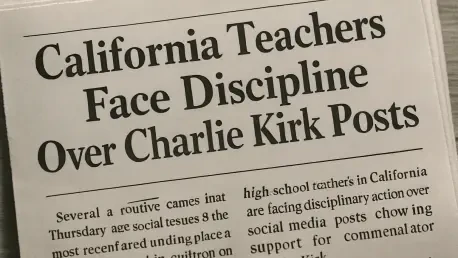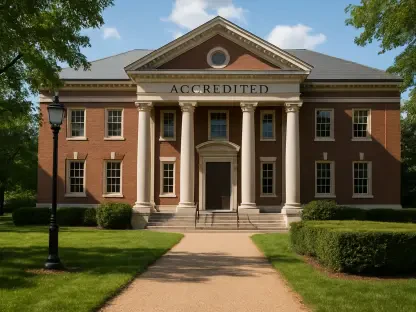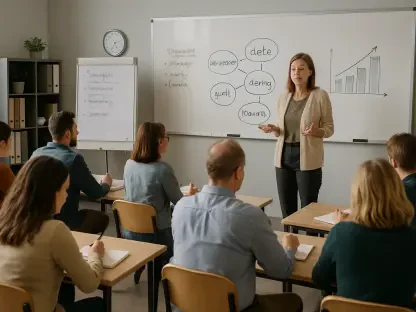In the aftermath of the tragic assassination of right-wing activist Charlie Kirk on September 10 at Utah Valley University, a wave of controversy has swept through California’s K-12 education system, placing at least 20 teachers under scrutiny for their social media posts. These educators, who made derogatory comments about Kirk during non-working hours, now face disciplinary actions ranging from paid leave to termination. This situation has sparked a heated debate over the delicate balance between free speech rights and the expectations of professional conduct within schools. As districts respond with swift measures, the broader implications for educators’ personal expression and the learning environment come into sharp focus, raising questions about where the line should be drawn.
The timing of these events, amidst a deeply polarized political climate, only amplifies the tension. Schools have increasingly become arenas for ideological battles, with the fallout from Kirk’s death—described as a politically motivated act—intensifying scrutiny on teachers’ online behavior. The clash between individual rights and institutional policies is evident in specific cases, such as a teacher from Pacheco Union School District in Redding who was fired for inflammatory remarks, and another from Dry Creek Unified School District in Roseville placed on administrative leave for derogatory language. Districts assert that such steps are necessary to maintain a respectful atmosphere, yet the personal toll on educators and potential disruptions to students’ education paint a far more intricate picture of the consequences at stake.
Free Speech vs. Professional Conduct
Navigating Legal Boundaries
The core of this ongoing controversy rests in the complex interplay between teachers’ constitutional right to free speech and the authority of school districts to regulate behavior that might disrupt the educational environment. California’s labor laws provide significant protections for political expression, ensuring that employees cannot be easily dismissed for their views. However, districts retain the ability to intervene if personal statements are seen as interfering with professional responsibilities or creating a hostile learning space. Legal experts, such as Erwin Chemerinsky from UC Berkeley Law School, contend that posts made on personal social media accounts outside of work hours are unlikely to have a direct impact on classroom dynamics. This perspective raises serious concerns about whether the disciplinary actions taken against these educators represent an overreach of authority, potentially infringing on rights that are meant to be safeguarded under state and federal law.
Defining Workplace Disruption
Beyond the legal framework, the debate also hinges on what constitutes a disruption to the workplace in the context of education. School districts argue that derogatory or inflammatory comments about public figures like Kirk, even if made privately, can undermine public trust in educators and create tension among students, parents, and staff. For instance, the Pacheco Union School District justified the termination of a teacher by emphasizing the need to uphold a safe and respectful environment, regardless of when or where the remarks were posted. Yet, critics of such decisions point out the lack of clear evidence linking off-hours social media activity to tangible harm in schools. This ambiguity fuels arguments that punitive measures may be more about enforcing conformity than addressing actual workplace issues, prompting a broader discussion on how far employers can go in policing personal expression without crossing into censorship territory.
Political Climate and Culture Wars
Education in the Crosshairs
The disciplinary actions against California teachers are not happening in isolation but are deeply entwined with the broader “culture wars” that have turned schools into battlegrounds for ideological conflict. The assassination of Charlie Kirk has heightened political tensions, with schools becoming focal points for debates over values and beliefs. The California Teachers Association (CTA) has expressed alarm, suggesting that targeting educators for their opinions is a deliberate strategy to silence dissent and instill fear. This perspective frames the current backlash as part of a larger effort to control narratives within education, particularly on contentious issues like parental rights policies that Kirk championed. As political polarization continues to seep into classrooms, the risk of educators self-censoring to avoid repercussions grows, potentially stifling open dialogue in spaces meant to foster critical thinking and diverse perspectives.
Polarization’s Ripple Effects
The ripple effects of this charged political atmosphere extend beyond individual teachers to influence entire school communities. Conservative activists argue that accountability is essential, asserting that parents should not have to worry about their children being taught by educators whose public statements reveal strong biases or hostility. This viewpoint aligns with movements Kirk supported, such as policies requiring parental notification regarding students’ gender identity. On the other side, union leaders and legal advocates caution against punitive measures that could set dangerous precedents, questioning how far such oversight might extend if criticism of other political figures were similarly penalized. This divide reflects a deeper societal rift over the role of politics in education, with schools caught between demands for neutrality and the reality of educators as individuals with personal views navigating an increasingly visible digital landscape.
Impact on Education Community
Personal and Professional Fallout
The consequences of disciplinary actions against California teachers are profound, affecting not only the individuals involved but also the broader educational ecosystem. Teachers facing penalties, such as job loss or administrative leave, endure significant personal and professional stress, with many lacking the financial resources to engage in prolonged legal battles. The CTA has highlighted this disparity, noting that the fear of retribution can deter educators from speaking out, even on matters unrelated to their work. Beyond the personal toll, these actions send a chilling message to others in the profession, suggesting that personal expression—however removed from the classroom—carries inherent risks. This climate of uncertainty undermines morale among educators, who already face numerous challenges in maintaining a supportive and effective learning environment for their students amid external pressures.
Disruptions to Student Learning
Equally concerning is the impact on students, who often bear the brunt of disruptions caused by mid-year teacher removals or reassignments. Continuity in education is vital for academic progress and emotional stability, yet the sudden absence of a teacher due to disciplinary measures can create gaps in learning and foster unease in the classroom. School districts may argue that such actions are necessary to preserve a safe and neutral environment, but the practical fallout often tells a different story. Students may struggle to adapt to new instructors, while the broader school community grapples with the tension surrounding these high-profile cases. As the trend of politicizing education persists, the stability of learning environments hangs in the balance, with long-term implications for how trust and respect are cultivated between educators, students, and families in an era of heightened scrutiny and ideological conflict.
Reflecting on Broader Implications
Lessons from a Polarized Era
Looking back, the disciplinary measures taken against California teachers in the wake of Charlie Kirk’s assassination revealed a critical juncture for education, where the boundaries of free speech and professional conduct were rigorously tested. The varied responses from school districts, ranging from termination to paid leave, underscored the absence of uniform standards, leaving educators vulnerable to inconsistent local decisions. The tension between maintaining a neutral learning environment and protecting constitutional rights played out in public discourse, with no easy resolution in sight. These events served as a stark reminder of how deeply political polarization had infiltrated schools, turning personal opinions into professional liabilities and exposing the fragility of trust within educational communities.
Moving Toward Balanced Solutions
As this chapter unfolded, it became clear that addressing such controversies required a nuanced approach that respected both individual freedoms and institutional responsibilities. School districts could benefit from clearer guidelines on handling off-hours speech, ensuring that disciplinary actions are grounded in evidence of actual disruption rather than public perception alone. Collaborative efforts between unions, legal experts, and educational bodies might pave the way for policies that protect teachers from undue retribution while addressing legitimate concerns about workplace impact. Encouraging dialogue over punishment could help de-escalate tensions, fostering environments where educators feel safe to express themselves without fear of professional ruin. Ultimately, the path forward lies in striking a balance that upholds the integrity of education while navigating the complexities of a digital and politically charged landscape.









